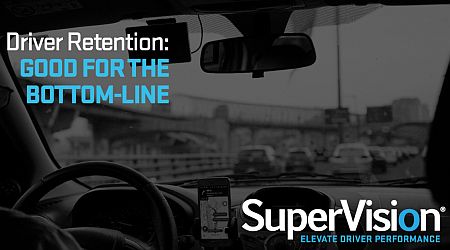
By Shannon McNamara, Marketing Manager — Fleet, SuperVision
One of the best ways to combat the driver shortage is by working to retain drivers. While money is important, a fleet culture that values and respects drivers may be even more crucial.
One of the most important ways fleets can overcome the perennial driver shortage is to find ways to retain the drivers they have.
Fleets across the country are instituting a wide variety of programs to hang on to what has become its most precious commodity — drivers — including better pay.
While there’s little doubt that pay is an important factor contributing to both the driver shortage and the ability to hold onto drivers, fleets need to do more than simply offer bonuses or raises: Drivers need to feel engaged by their work.
CULTIVATING ENGAGEMENT
Fundamentally, engagement simply means being fulfilled by one’s job. An engaged employee will likely go above and beyond, look for ways to save and make the company more money, and, most importantly, stick around for the long haul.
To put it in a bottom-line perspective, a 2012 Gallup analysis found that organizations in the top 25% of employee engagement outperformed the bottom 25% by 22% in profitability and 21% in productivity. Simply put, it pays to have an engaged workforce.
The solution is relatively straightforward and cost-effective: Cultivate a culture where a driver feels valued and respected. Not feeling valued and respected is the No. 1 reason drivers will leave their companies, according to industry experts.
Demonstrating value and respect should start during the recruiting and onboarding period, and include:
- Keeping promises made during the hiring process — nothing will disengage a new, eager employee than discovering the recruiting pitch didn’t live up to expectations
- Giving the new driver a warm welcome on his or her first day
- Providing onboarding that reflects the company’s stated values of professionalism, respect, and honesty
- Introducing new drivers to key members of the organization, including company leadership — the driver should feel that he or she is an integral part of the company
- Setting clear, consistent expectations
These are only some of the many ways a fleet can build engagement and loyalty during the onboarding process. The importance of engaging drivers from the outset can’t be stressed enough. It is estimated that most new hires decide within the first 72 hours if they’ll stay with the company long-term or leave at the first opportunity.
After onboarding, communication — such as phone calls, newsletters, and social media — can be used to create engagement, particularly for long-haul drivers who may be away from home base for weeks at a time.
Having a nice work environment is another way to build engagement and loyalty. If the fleet and its company are willing to provide a well-maintained, late-model truck for its drivers, it’s a signal that their employees are of high value to the company.
Providing opportunity may also be a path to engagement and loyalty. Giving drivers opportunities to advance is another way to build engagement. These opportunities can be presented during the recruitment process.
MAKING IT WORTHWHILE
While building engagement through better onboarding, communication, equipment, and opportunities is crucial, drivers also need pay that reflects their value as well.
It is estimated that compensation needs to be at least $75,000 annually to cut driver turnover. The good news is that many companies are reporting that they’re either increasing per-mile pay or performance-based bonuses (depending on the size of the fleet).
A raise — no matter the form —makes bottom-line business sense. SuperVision estimates that each 1% improvement in retention will net your company $40,000 in bottom-line savings.
PREDICTING DRIVER RETENTION
Developing a culture that values drivers is important. But culture isn’t enough to guarantee that drivers will stay with the fleet.
SuperVision’s Driver Retention can help fleet managers monitor driver satisfaction and predict the drivers that are most likely to leave the company. This gives the fleet manager and other company leaders an opportunity to talk to the driver and correct the problem — in essence, re-engage the driver.
Driver Retention helps fleet managers monitor and be proactive about communicating with drivers and document the driver’s satisfaction. At an enterprise level, fleet managers and company leadership can measure the fiscal benefits of retention and map driver-turnover trends.
Driver retention can be challenging, but with an engagement mindset and the right tools, it can be one of the most valuable things you do as a fleet manager.
RETENTION PERFORMER – LEARN MORE
https://esupervision.com/retention-performer
>
The post Driver Retention: Good for the Bottom Line appeared first on Fleet Management Weekly.
from Fleet Management Weekly https://ift.tt/2kV2Yup



Sourced by Quik DMV - CADMV fleet registration services. Renew your registration online in only 10 minutes. No DMV visits, no lines, no phone mazes, and no appointments needed. Visit Quik, Click, Pay & Print your registration from home or any local print shop.





0 comments:
Post a Comment